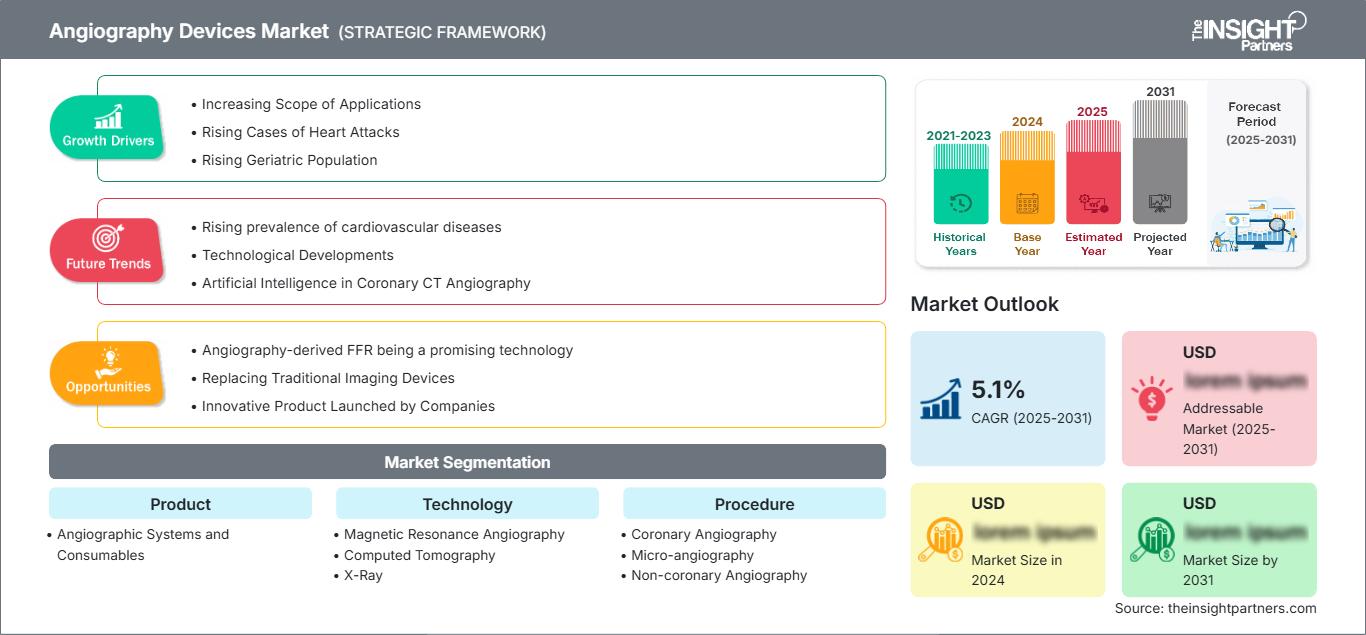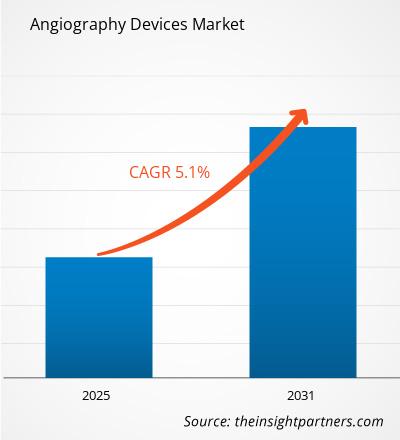Si prevede che il mercato dei dispositivi per angiografia raggiungerà i 19,24 miliardi di dollari entro il 2031. Si prevede che il mercato registrerà un CAGR del 5,8% nel periodo 2025-2031.
Il rapporto è segmentato in base al mercato dei dispositivi per angiografia per prodotto (sistemi e materiali di consumo angiografici), tecnologia [angiografia a risonanza magnetica (MRA), tomografia computerizzata (TC), raggi X e altre tecnologie], procedura (angiografia coronarica, microangiografia, angiografia non coronarica e altre), applicazione (diagnostica e terapeutica), indicazione (cardiopatia congenita, insufficienza cardiaca congestizia, valvulopatia, coronaropatia nota e sospetta (CAD) e altre), utente finale (ospedali, centri diagnostici, centri chirurgici ambulatoriali e laboratori di ricerca accademica) e area geografica (Nord America, Europa, Asia). Pacifico, Medio Oriente e Africa e America meridionale e centrale). L'analisi globale è ulteriormente suddivisa a livello regionale e per i principali paesi. Il rapporto offre il valore in USD per l'analisi e i segmenti sopra indicati.
Scopo del rapporto
Il rapporto "Angiography Devices Market" di The Insight Partners mira a descrivere il panorama attuale e la crescita futura, i principali fattori trainanti, le sfide e le opportunità. Ciò fornirà spunti a vari stakeholder aziendali, come:
- Fornitori/produttori di tecnologia: per comprendere le dinamiche di mercato in evoluzione e conoscere le potenziali opportunità di crescita, consentendo loro di prendere decisioni strategiche informate.
- Investitori: per condurre un'analisi completa delle tendenze in merito al tasso di crescita del mercato, alle proiezioni finanziarie di mercato e alle opportunità esistenti lungo la catena del valore.
- Enti di regolamentazione: per regolamentare le politiche e le attività di controllo sul mercato con l'obiettivo di ridurre al minimo gli abusi, preservare la fiducia degli investitori e sostenere l'integrità e la stabilità del mercato.
Segmentazione del mercato dei dispositivi per angiografia Prodotto
- Sistemi e materiali di consumo angiografici
Tecnologia
- Angiografia a risonanza magnetica
- Tomografia computerizzata
- Raggi X
- Altre tecnologie
Procedura
- Angiografia coronarica
- Microangiografia
- Angiografia non coronarica
- Altri
Applicazione
- Diagnostica
- Terapeutica
Indicazione
- Cardiopatia congenita
- Insufficienza cardiaca congestizia
- Valvola cardiaca
- Arteria coronaria nota e sospetta Malattia
Potrai personalizzare gratuitamente qualsiasi rapporto, comprese parti di questo rapporto, o analisi a livello di paese, pacchetto dati Excel, oltre a usufruire di grandi offerte e sconti per start-up e università
Mercato dei dispositivi per angiografia: Approfondimenti strategici

- Ottieni le principali tendenze chiave del mercato di questo rapporto.Questo campione GRATUITO includerà l'analisi dei dati, che vanno dalle tendenze di mercato alle stime e alle previsioni.
Fattori di crescita del mercato dei dispositivi angiografici
- Campo di applicazione crescente: i dispositivi angiografici vengono utilizzati per controllare la salute dei vasi sanguigni e il modo in cui il sangue li attraversa. Possono aiutare a diagnosticare o indagare diversi problemi che interessano i vasi sanguigni, tra cui: aterosclerosi (restringimento delle arterie). Aiutano a eseguire interventi chirurgici mininvasivi complessi e delicati.
- Casi di infarto in aumento: l'aumento della prevalenza di infarti è probabilmente il motore della crescita del mercato. Secondo i Centers for Disease Control and Prevention (CDC), circa ogni 40 secondi un americano avrà un infarto. Ogni anno, 805.000 americani hanno un infarto, 605.000 dei quali per la prima volta. Circa il 12% delle persone colpite da infarto ne morirà.
- Aumento della popolazione geriatrica: si stima che nel 2020 la popolazione di età pari o superiore a 60 anni fosse pari a 1 miliardo. Entro il 2050, la popolazione mondiale di persone di età pari o superiore a 60 anni raddoppierà (2,1 miliardi). Si prevede che il numero di persone di età pari o superiore a 80 anni triplicherà tra il 2020 e il 2050, raggiungendo i 426 milioni.
Tendenze future del mercato dei dispositivi angiografici
- Crescente prevalenza di malattie cardiovascolari: il numero annuo di decessi per malattie cardiovascolari (CVD) in India è aumentato da 2,26 milioni (1990) a 4,77 milioni nel 2020. I tassi di prevalenza delle malattie coronariche in India sono stati stimati negli ultimi decenni e variavano dall'1,6% al 7,4% nelle popolazioni rurali e dall'1% al 13,2% nelle popolazioni urbane a partire dal 2023.
- Sviluppi tecnologici: l'angiografia con tomografia computerizzata (TC) è una tecnologia innovativa e viene utilizzata come alternativa ai test da sforzo. L'angiografia coronarica con TC è un esame diagnostico non invasivo che può determinare la presenza, la quantità e la gravità della placca aterosclerotica nelle arterie cardiache. L'attrezzatura essenziale necessaria per l'angiografia convenzionale include: un set di cateteri e guide.
- Intelligenza artificiale nell'angiografia coronarica con TC: la malattia coronarica (CHD) è la principale causa di mortalità nel mondo. La diagnosi precoce e il trattamento della CHD sono cruciali. Attualmente, l'angiografia coronarica con TC (CCTA) è stata la scelta prioritaria per lo screening e la diagnosi della CHD, ma non è in grado di soddisfare le esigenze cliniche in termini di qualità dell'esame, accuratezza della refertazione e accuratezza dell'analisi prognostica. Negli ultimi anni, l'intelligenza artificiale (IA) si è sviluppata rapidamente nel campo della medicina; Ha svolto un ruolo chiave nella diagnosi ausiliaria, nell'analisi dei meccanismi della malattia e nella valutazione della prognosi, inclusa una serie di studi relativi alla cardiopatia coronarica.
Opportunità di mercato per i dispositivi angiografici
- La FFR derivata dall'angiografia è una tecnologia promettente: la FFR derivata dall'angiografia si è affermata come una tecnologia promettente nel campo della cardiologia interventistica. Con i progressi negli algoritmi software e nelle tecniche di elaborazione delle immagini, sono stati compiuti progressi significativi nel migliorare l'accuratezza e la riproducibilità delle misurazioni della FFR derivate dalle immagini angiografiche.
- Sostituzione dei dispositivi di imaging tradizionali: l'angiografia presenta numerosi vantaggi in quanto consente di ottenere immagini dinamiche in tempo reale utilizzando un dispositivo di imaging tradizionale come i raggi X o la tomografia computerizzata (TC), e offre anche opzioni terapeutiche al momento della diagnosi iniziale. I progressi nella tecnologia di imaging negli ultimi tre decenni hanno ampliato il campo di applicazione dell'angiografia, includendo tecniche non invasive che utilizzano la TC e la risonanza magnetica.
- Prodotto innovativo lanciato dalle aziende: nell'aprile 2022, Shimadzu Corporation ha avviato le vendite mondiali del suo sistema angiografico di punta Trinias. Il nuovo sistema Trinias utilizza la tecnologia di apprendimento profondo basata sull'intelligenza artificiale per migliorare la visibilità dei dispositivi medici, utilizzando una dose di raggi X inferiore del 40% o più rispetto ai modelli precedenti. Questa implementazione dell'intelligenza artificiale nel motore di elaborazione delle immagini di un sistema angiografico ha rappresentato una svolta rivoluzionaria per l'azienda.
Mercato dei dispositivi per angiografia
Le tendenze regionali e i fattori che influenzano il mercato dei dispositivi per angiografia durante il periodo di previsione sono stati ampiamente spiegati dagli analisti di The Insight Partners. Questa sezione illustra anche i segmenti di mercato e la geografia della gestione delle malattie del ritmo cardiaco in Nord America, Europa, Asia-Pacifico, Medio Oriente e Africa, America meridionale e centrale.
Ambito del rapporto di mercato sui dispositivi per angiografia
| Attributo del rapporto | Dettagli |
|---|---|
| Dimensioni del mercato in 2024 | US$ XX Billion |
| Dimensioni del mercato per 2031 | US$ 19.24 Billion |
| CAGR globale (2025 - 2031) | 5.8% |
| Dati storici | 2021-2023 |
| Periodo di previsione | 2025-2031 |
| Segmenti coperti |
By Prodotto
|
| Regioni e paesi coperti | Nord America
|
| Leader di mercato e profili aziendali chiave |
|
Densità degli operatori del mercato dei dispositivi angiografici: comprendere il suo impatto sulle dinamiche aziendali
Il mercato dei dispositivi per angiografia è in rapida crescita, trainato dalla crescente domanda degli utenti finali, dovuta a fattori quali l'evoluzione delle preferenze dei consumatori, i progressi tecnologici e una maggiore consapevolezza dei vantaggi del prodotto. Con l'aumento della domanda, le aziende stanno ampliando la propria offerta, innovando per soddisfare le esigenze dei consumatori e sfruttando le tendenze emergenti, alimentando ulteriormente la crescita del mercato.

- Ottieni il Mercato dei dispositivi per angiografia Panoramica dei principali attori chiave
Punti di forza
- Copertura completa: il rapporto analizza in modo esaustivo prodotti, servizi, tipologie e utenti finali del mercato dei dispositivi per angiografia, offrendo una panoramica olistica.
- Analisi degli esperti: il rapporto è redatto sulla base della conoscenza approfondita di esperti e analisti del settore.
- Informazioni aggiornate: il rapporto garantisce la pertinenza aziendale grazie alla copertura di informazioni e tendenze dei dati recenti.
- Opzioni di personalizzazione: questo rapporto può essere personalizzato per soddisfare le esigenze specifiche del cliente e adattarsi in modo appropriato alle strategie aziendali.
Il rapporto di ricerca sul mercato dei dispositivi per angiografia può quindi contribuire a guidare il percorso di decodifica e comprensione dello scenario del settore e delle prospettive di crescita. Sebbene possano esserci alcune valide preoccupazioni, i vantaggi complessivi di questo rapporto tendono a superare gli svantaggi.
- Analisi storica (2 anni), anno base, previsione (7 anni) con CAGR
- Analisi PEST e SWOT
- Valore/volume delle dimensioni del mercato - Globale, Regionale, Nazionale
- Industria e panorama competitivo
- Set di dati Excel
Report recenti
Testimonianze
Motivo dell'acquisto
- Processo decisionale informato
- Comprensione delle dinamiche di mercato
- Analisi competitiva
- Analisi dei clienti
- Previsioni di mercato
- Mitigazione del rischio
- Pianificazione strategica
- Giustificazione degli investimenti
- Identificazione dei mercati emergenti
- Miglioramento delle strategie di marketing
- Aumento dell'efficienza operativa
- Allineamento alle tendenze normative






















 Ottieni un campione gratuito per - Mercato dei dispositivi per angiografia
Ottieni un campione gratuito per - Mercato dei dispositivi per angiografia